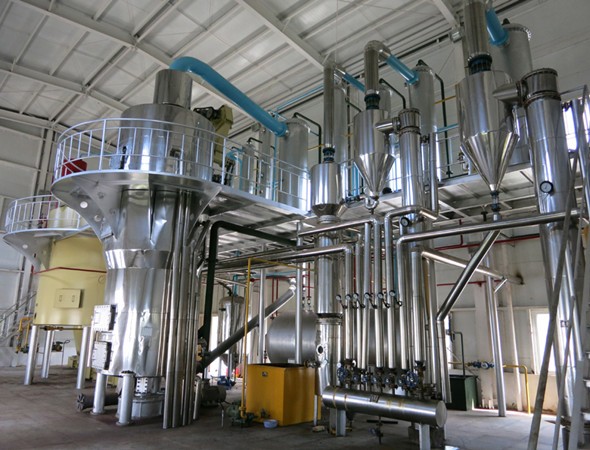Evaporation operation is an important process in the leaching workshop. In order to obtain a good evaporation effect, the comprehensive influence of equipment factors, operating factors, and oil factors must be fully considered. These factors are intricate and affect each other.
Ⅰ: Influencing factors and analysis of evaporation
1. The inlet temperature of the mixed oil
The inlet oil temperature is low, and part of the evaporator only serves as a heater. The mixed oil cannot effectively form a rising film to evaporate; the inlet oil temperature is high, and the material has been vaporized during feeding, causing air resistance, which is not conducive to feeding and forming a liquid film. Affect heat exchange and reduce evaporation effect.
2. Concentration of mixed oil
The purpose of evaporation is to require the higher the concentration of the mixed oil, the better, but the concentration increases:
(1) The boiling point of the mixed oil increases accordingly, and the high boiling point ① requires a higher air pressure ② affects the quality of the crude oil.
(2) Film is not easy to rise. For example, the concentration of the mixed oil coming out of the first long tube evaporator is too high, and the high concentration of mixed oil is not easy to form a rising film in the second long tube evaporator. Especially when the solvent in the film evaporates, the rising film will stop or slow down. This phenomenon is called "dry wall phenomenon". It can be adjusted by controlling the indirect steam of the long tube evaporator.
3. Impurities (meal powder, sugars, phospholipids, moisture, etc.)
The less the better, because:
(1) Impurities cause a large amount of foam in the mixed oil, causing flooding;
(2) Fouling of the pipe wall, affecting heat transfer;
(3) The color of grease is deepened and the quality is reduced.
4. Steam pressure
(1) The pressure is low, the temperature difference is small, and the amount of evaporation is small. The mixed oil cannot be vaporized in time when it enters the evaporator, and the mixed oil in the tube does not boil, and it is not easy to form a liquid film. The pressure is high, the temperature difference is large, and the evaporation is fast. The liquid film is destroyed due to rapid vaporization, which is not conducive to heat transfer and evaporation. At this time, the tube wall is almost covered by solvent vapor and is not wetted by the mixed oil liquid, and the heat transfer coefficient is reduced.
(2) Excessive pressure leads to high oil temperature, which affects the quality of crude oil.
5. Evaporation
The output is moderate, continuous and stable. Keep the mixed oil at a certain level in the evaporator.
6. Evaporation equipment
No scaling, no leakage, etc. In some facilities, the mixed oil pretreatment process is not effective, causing a large amount of impurities to enter the evaporation system, which not only greatly reduces the evaporation process effect, but also seriously blocks the evaporator and heat exchanger, which must be resolutely avoided.
7. Negative pressure operation
The higher the vacuum, the better, too high will also cause flooding.
Ⅱ: Control analysis of evaporation operation:
1. The absolute pressure of one steam is 300-450mbar, the concentration of mixed oil at the outlet is 80-90%, and the temperature of one steam is 55-60℃. The vacuum degree of the second steam is 300-450mbar, the outlet mixed oil concentration is 95-99%, and the temperature of the second steam oil is 105-110℃.
2. The oil in and out of the steam is continuously stable to prevent flow fluctuations from affecting the evaporation effect and the impact of the oil-oil heat exchanger. Pay attention to the evaporation vacuum, oil temperature and oil level to prevent flooding.
In summary, whether
the evaporation process of grease can proceed smoothly is determined by many factors. These factors are intricate and affect each other. Therefore, if these factors can be dialectically grasped in the evaporation production, and they can be used well, the evaporation efficiency can be effectively improved, the occurrence of process failures such as dry wall and liquid flooding can be reduced, and the quality of crude oil can be greatly improved.


